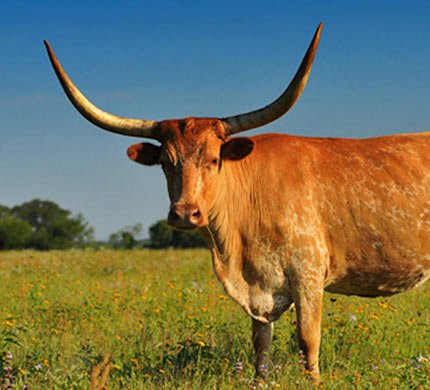Texas Longhorn
- Temperature:40-80°F
- Milk:2 to 10 gallons
- Food:Grass, Forbs and Cacti
- Pregnancy:280 days
- Nationality:United States

General Information
Texas Longhorns are often seen as a symbol of Texas and the American West. Their distinctive horns are often used in logos and other imagery associated with the state.
They are known for their endurance and ability to travel long distances without water or food. This made them well-suited for the long cattle drives from Texas to railheads in Kansas in the late 1800s.
Texas Longhorns have a natural resistance to many diseases and pests that affect other breeds of cattle, making them easier to maintain and less expensive to raise.
They are a low-maintenance breed, requiring minimal human intervention or specialized care. This makes them a popular choice for ranchers who have large herds and limited resources.
Where we find this cow to buy?
If you are interested in purchasing Texas Longhorn cattle, there are several options available:
01. Private breeders : There are many private breeders of Texas Longhorn cattle throughout the United States. You can search online for breeders in your area or contact the Texas Longhorn Breeders Association for a list of breeders.02. Livestock auctions : Many livestock auctions sell Texas Longhorn cattle, particularly in areas where the breed is popular.03. Online Marketplaces : There are several online marketplaces where you can find Texas Longhorn cattle for sale, including Craigslist, Livestock Of America, and Ranch World Ads.

How to increase milk production in Texas Longhorn
There are several ways to increase milk production in Texas Longhorn cattle. Here are some tips:
01
Ensure this cows are receiving a balanced diet with high-quality forage and supplements. Consult with a veterinarian or animal nutritionist to develop a feeding plan.
02
Proper herd management practices can help reduce stress on Texas Longhorns, leading to improved milk production.
03
Make sure that your Texas Longhorns have access to clean, fresh water at all times. Dehydration can reduce milk production.
04
Select breeding bulls with high milk production genetics. Breeding for milk production can result in higher milk yields in subsequent generations.
Medicine
Like all cattle, Texas Longhorns may require medication at various times throughout their lives. Some common medicines used in the treatment and prevention of illnesses in Texas Longhorns include:
01
AntibioticsAntibiotics should only be used by a veterinarian and followed by withdrawal times to ensure safe consumption of treated animals.
02
DewormersInternal parasites can cause weight loss, decreased milk production, and other health issues in Texas Longhorns.
03
VaccinesVaccines are used to prevent common diseases such as blackleg, respiratory diseases, and reproductive diseases.
04
Fly control productsFly control products such as sprays, pour-ons, and ear tags can help to control flies, which can cause discomfort and spread diseases.
Pregnancy
When a Texas Longhorn is close to calving, it is important to provide a clean and comfortable area for the cow to give birth. It is also important to monitor the cow closely during calving to ensure that the process goes smoothly and any potential complications are addressed promptly.
When a Texas Longhorn is close to calving, it is important to provide a clean and comfortable area for the cow to give birth. It is also important to monitor the cow closely during calving to ensure that the process goes smoothly and any potential complications are addressed promptly.
Pregnant Texas Longhorns should be provided with a balanced diet with high-quality forage sources and supplements recommended by a veterinarian.
The pregnancy of a Texas Longhorn can be diagnosed using several methods, including ultrasound or palpation by a veterinarian.
Important!
It is important to note that the specific steps and care required during Texas Longhorn pregnancy may vary depending on individual circumstances and the advice of a veterinarian.
Food
Texas Longhorns are a hardy breed of cattle that is well adapted to grazing on a variety of forage sources. Here are some common types of food that are fed to Texas Longhorns:
Grass is a primary source of nutrition for Texas Longhorns. They graze on natural pastures, as well as hay or silage made from grasses.
Forbs are broadleaf plants that are often found in natural pastures. They are a good source of nutrition for Texas Longhorns and can help provide a varied diet.
Texas Longhorns are known for their ability to graze on cacti, such as prickly pear, which are abundant in the southwestern United States.
In addition to forage, Texas Longhorns may be fed concentrated feeds such as grains or other protein supplements to meet their nutritional needs.
Facts
Here are some interesting facts about Texas Longhorn cattle:
They are a breed of cattle that originated in the United States in the 1800s.
They are known for their adaptability to a variety of climates and terrains.
Texas Longhorns’ horns are the longest of any cattle breed, reaching up to 7 feet from tip to tip.
They are raised for beef production and rodeo events.
Texas Longhorns come in a variety of colors, including red, white, black, yellow, and brown. They may also have spots or speckles.
They have a high tolerance for heat and can graze in temperatures exceeding 100 degrees Fahrenheit (38 degrees Celsius).
They have a natural resistance to many diseases, reducing the need for medication and veterinary care.
Conservation efforts have helped to increase the Texas Longhorn population, which was nearly extinct in the 20th century.